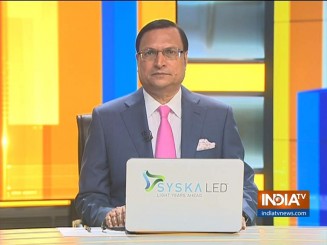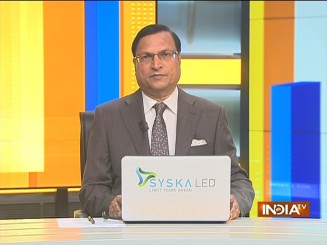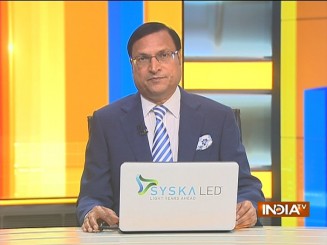Adani group is not sinking: Let us not deride our wealth creators
 Both Houses of Parliament were rocked for the second consecutive day today on the issue of Gautam Adani’s group of companies. Opposition leaders demanded discussion on what they called ‘financial irregularities’ in sanction of loans from public sector banks to Adani group in the light of Hindenburg research report, whose allegations have been comprehensively denied by the group.
Both Houses of Parliament were rocked for the second consecutive day today on the issue of Gautam Adani’s group of companies. Opposition leaders demanded discussion on what they called ‘financial irregularities’ in sanction of loans from public sector banks to Adani group in the light of Hindenburg research report, whose allegations have been comprehensively denied by the group.
Congress and other opposition leaders are pressing for setting up a Joint Parliamentary Committee to probe into the entire issue. Reserve Bank of India has sought details from all banks which have sanctioned loans to Adani group. Gautam Adani has clarified that his companies have not committed any financial irregularities, and all its transactions are in black and white. He has also clarified that his companies have not defaulted on any payment nor have caused financial loss to anybody. He has also announced that he was withdrawn his FPO (Follow on Public Offer) due to current market volatility, though it has been fully subscribed.
The questions that arise now is whether the short seller firm Hindenburg has Adani group shares? Will it be right to accept a foreign research firm’s report as authentic? Or, should we repose our trust in RBI and SEBI?
Congress has raised questions on why LIC and SBI heavily invested in Adani group shares. Both LIC and SBI have said that they have not faced any loss. Is the Adani issue a mere façade for the opposition to target Prime Minister Narendra Modi? One must understand that Adani group’s business, its share value and wealth increased when the UPA government was in power.
Even during the last nine years of Modi’s rule, Congress-ruled state governments went out of their way to invite Adani group to invest in projects in their states.
The attack by opposition on Adani issue is not new. Years before the Hindenburg research report came before public, Congress leader Rahul Gandhi had been harping on the Adani-Ambani theme, and alleging that Prime Minister Modi was working to favour these two top industrialists. With the steep drop in prices of Adani group shares in the stock market, the opposition has got a fresh weapon to attack Modi.
The fact remains that Adani group’s fortunes took a meteoric rise when Prime Minister Rajiv Gandhi was in power and Chimanbhai Patel was the chief minister of Gujarat. During P V Narasimha Rao’s rule, when the new economic era dawned, Adani opened new businesses, created brand values and achieved tremendous growth.
When infrastructure picked up during Prime Minister Modi’s rule, Gautam Adani’s group took wings, setting up ports, power plants and other projects. Political analyst Dr Ajay Alok says, Gautam Adani’s success story is an inspiring one which should be taught to students. From Rs 2 crore net worth during Congress rule, Adani’s turnover rose to Rs 80,000 crore during Dr Manmohan Singh’s UPA rule.
It is a known fact that Adani group got projects when Rajiv Gandhi, Dr Manmohan Singh, Chimanbhai Patel, Uddhav Thackeray, Ashok Gehlot and even Kerala’s CPI-M leader Pinarayi Vijayan were in power. The entire hullaballoo that is now being created is more political, and less financial. Gautam Adani says, the allegations that have been made in Hindenburg report were 15 to 20 years old, and his group has already got a clean chit from Supreme Court.
Life Insurance Corporation of India, on Thursday, clarified that its investment in Adani group companies is merely one per cent of its total capital market investment. Even if Adani group’s market capitalization declines to zero, LIC will not face a financial loss. LIC said, it invested Rs 30,127 crore in Adani group companies, whose market value was Rs 56,142 crore as on Monday.
State Bank of India said, it has given $ 2.6 billion ( Rs 21,000 crore) loan to Adani group companies, but till now, Adani group has not made any default in loan repayments. On the basis of Adani group’s capital assets pledged as guarantee, SBI’s investments are secure.
Punjab National Bank said, it gave Rs 7,000 crore loan to Adani group. Several private banks have also given loans to the group. Even if all the loans of Indian and international banks are clubbed together, it is lesser than the total value of Adani’s personal properties. Adani’s net worth is more than the bank loans, it has adequate cash flow, and in the last several years, the group’s earnings have been more than its loans. So, there is no question of default in servicing debts.
Overall, neither Prime Minister Modi has fewer enemies, nor Gautam Adani has fewer people who are jealous about his meteoric growth. The Hindenburg research report has come as an excuse to target both Modi and Adani. People are trying to create an impression that Adani’s miraculous growth is just a bubble about to burst and his business will wind up, but they are misleading people. Adani group is not sinking.
Let me tell you the value of Gautam Adani’s businesses and assets. His group owns Gangavaram, Mundhra and Hazira ports. In Vizhinjam, Kerala, Adani group is building a deep water port comparable to Singapore and Colombo. Adani group’s thermal power units generate 13,500 MW, most of which come under clean energy category. The group has capacity to generate 650 MW solar power. Its 18,000 circuit km transmission lines and 30,000 MVA transfer capacity is Asia’s largest.
Adani group owns six airports, apart from partnership in Mumbai airport. Navi Mumbai airport to be opened in 2025 will be operated by Adani group. It owns two top cement companies, ACC and Ambuja Cement. India’s busiest special economic zone port in Mundra belongs to Adani group. It owns coal mines in Australia that supply high-grade coal to power plants in India. It is partner in NTPC’s under construction solar and wind energy plant.
Adani Ports, Adani Power, Adani Green Energy, Adani Wilmar, Adani Total Gas, all these companies that come under the flagship Adani Enterprises Ltd make immense contribution to India’s infra development and growth.
In conclusion, let me say, Gautam Adani is an industrialist. It does not matter if his net worth rises or declines, but the ports, thermal power stations, airports and power transmission lines that his group has built, are not meant for his personal use. They are national assets.
If we make political attacks on any industrialist, whosoever he may be, it will only cause harm to our national interest. We must remember one point: All over the world, people support their wealth creators, they give them due respect, but there are people in India, who raise doubts, create scares and controversies and deride our wealth creators. I think such a mindset needs to be changed.
नरेंद्र मोदी ने कैसे बजट की परिभाषा बदल डाली
 अब जबकि केंद्रीय बजट का पूरा ब्यौरा सामने आ चुका है और अर्थशास्त्री, आयकर विशेषज्ञ एवं पूंजी बाजार के विश्लेषक बजट प्रस्ताव के आंकड़ों का बारीकी से अध्ययन करने में जुटे हैं, इस बजट पर एक विहंगम दृष्टि डालने की जरूरत है। देश का मध्यम वर्ग इनकम टैक्स में दी गई राहत से खुश है, अमीर करदाता भी खुश हैं, जबकि महिलाओं, वरिष्ठ नागरिकों, युवाओं और किसानों ने नई योजनाओं का स्वागत किया है।
अब जबकि केंद्रीय बजट का पूरा ब्यौरा सामने आ चुका है और अर्थशास्त्री, आयकर विशेषज्ञ एवं पूंजी बाजार के विश्लेषक बजट प्रस्ताव के आंकड़ों का बारीकी से अध्ययन करने में जुटे हैं, इस बजट पर एक विहंगम दृष्टि डालने की जरूरत है। देश का मध्यम वर्ग इनकम टैक्स में दी गई राहत से खुश है, अमीर करदाता भी खुश हैं, जबकि महिलाओं, वरिष्ठ नागरिकों, युवाओं और किसानों ने नई योजनाओं का स्वागत किया है।
बजट के पूरे विवरण में न जाकर हमें निर्मला सीतारमण के इस बजट की दो बातें समझनी होंगी।
पहला : कोरोना की महामारी ने पूरी दुनिया में हर मुल्क की अर्थव्यवस्था को बर्बाद कर दिया है। आज अमेरिका और यूरोप के बड़े-बड़े मुल्क इस मार से उबर नहीं कर पाए हैं। वहां महंगाई और बेरोजगारी से लोग परेशान हैं। लोगों को नौकरियों से निकाला जा रहा है। हमारे पड़ोसी मुल्क पाकिस्तान में तो लोग दो वक्त की रोटी के लिए तरस रहे हैं। लेकिन भारत कोरोना महामारी की मार से पूरी तरह उबर गया है। आज हम कोरोना से पहले वाली स्थिति में पहुंच गए हैं। पूरी दुनिया भारत को सबसे तेजी से बढ़ती अर्थव्यवस्था मानती है।
दूसरी बात,अब ये समझने की जरूरत है कि भारत ऐसा क्यों कर पाया ? ऐसा इसलिए हुआ कि प्रधानमंत्री नरेन्द्र मोदी ने हमेशा देश की अर्थव्यवस्था के बारे में एक दीर्घकालीन दृष्टिकोण से काम किया। 2014 में अरुण जेटली ने मोदी सरकार का पहला बजट पेश किया था। अगर आप गौर से देखें तो तब से लेकर इस साल तक के सभी सालाना बजट आपस में जुड़े हुए हैं। इससे पहले बजट एक साल के लिए होते थे। वे साल की आर्थिक और राजनीतिक जरूरतों को पूरा करने के लिए होते थे। नरेंद्र मोदी ने इस सोच को बदला। उन्होंने बजट की परिभाषा और शब्दावली को ही बदल दिया। इसलिए हमें भी मोदी के बजट को देखने का तरीका बदलना होगा।
मोदी से पहले बजट का मतलब होता था क्या सस्ता हुआ, क्या मंहगा हुआ, किस चीज पर ज्यादा एक्साइज या कस्टम ड्यूटी लगी और कौन सा प्रोडक्ट बच गया। मुझे याद है बजट के महीनों पहले औद्योगिक घरानों की तरफ से लॉबिंग होने लगती थी। हर व्यापारी सिर्फ अपने फायदे के लिए अपने उत्पाद या अपनी वस्तुओं पर ड्यूटी (शुल्क) कम करने के लिए दौड़ता था, लॉबिंग करता था। लेकिन अब ये नहीं होता।
पिछले नौ साल से बजट में ओवर ऑल डेवलपमेंट (समग्र विकास) और ग्रोथ की बात होती है। निर्मला सीतारामन ने भी लगातार पांचवें साल इसी रास्ते को फॉलो किया। देश जब 2047 में आजादी की 100 वीं वर्षगांठ मना रहा होगा (जिसे ‘अमृत काल’ का नाम दिया गया है ), तब हमारी अर्थव्यवस्था कैसी होगी, निर्मला सीतारामन ने इसकी बात की।
कुछ लोगों का कहना है कि यह चुनावी बजट है। मेरा कहना है कि अगर मोदी की नीतियों से लोगों को घर मिले, बिजली मिली, नल से जल मिला, शौचालय मिले, गैस मिली, दो वक्त की दाल रोटी मिली तो इसमें बुरा क्या है? अगर सरकार ऐसे बजट और ऐसी योजनाएं बनाए, जिसका सीधा लाभ लोगों तक पहुंचे तो इसे अच्छा संकेत मानना चाहिए।
बुधवार को पेश बजट में जो आंकड़े सामने आए उससे पता चला कि पिछले नौ साल में भारत की प्रति व्यक्ति आय दोगुनी हो गई है। भारत की अर्थव्यवस्था पहले दुनिया में दसवें नंबर पर थी लेकिन अब यह पांचवें नंबर पर आ गई है। यह अच्छा संकेत है और उम्मीद करनी चाहिए कि 2047 में हम दुनिया की पहली दो अर्थव्यवस्थाओं में से एक होंगे।
How Narendra Modi changed the very definition of Union Budget
 Now that full details of the Union Budget are out, and economists, income tax experts and capital market analysts continue to grapple with figures and minutely go through the fine print in Finance Bill proposals, it is time to take an overall view. The Indian middle class is elated over Income Tax relief, rich taxpayers are also happy, while women, senior citizens, youths and farmers have welcomed the new schemes.
Now that full details of the Union Budget are out, and economists, income tax experts and capital market analysts continue to grapple with figures and minutely go through the fine print in Finance Bill proposals, it is time to take an overall view. The Indian middle class is elated over Income Tax relief, rich taxpayers are also happy, while women, senior citizens, youths and farmers have welcomed the new schemes.
Without going into details of the Budget, one must understand two points from Nirmala Sitharaman’s Budget.
One: At a time when Covid pandemic has devastated the economies of most of the countries of the world, with the US and other big nations of Europe yet to recover fully from recession, inflation and unemployment, at a time when neighbouring Pakistan is struggling to keep afloat due to sinking economy, with poor Pakistanis clamouring for two decent meals a day, India, under Prime Minister Narendra Modi, recovered fully from the effects of pandemic. We can say today with confidence that Indian economy has almost reached the pre-Covid situation. The entire world recognises India as the fastest growing economy.
Two: One must try to understand how India managed this miraculous recovery. I have no hesitation in saying that it was Prime Minister Narendra Modi, who, throughout his tenure, brought about changes in the economy with a long-term vision.
Arun Jaitley as Finance Minister had prepared the first Budget of Modi government in 2014. If you look thoroughly, all the annual Budgets since then till this year, are inter-linked. They appear to be in continuation. Earlier, Union Budget used to be prepared only for that fiscal year: to fulfil economic and political needs. Narendra Modi changed this way of thinking. He completely changed the definition and lexicon of the Union Budget. We should, therefore, change our manner of looking at annual budgets of the Union government.
During pre-Modi years, the man on the street and the industrialists sitting in their offices, used to be curious about which goods have become cheaper, or costlier. Which product faced higher excise or custom duties, and which products were left out. I remember those days when industrial houses used to engage in lobbying months before the preparation of Budget, and big industrialists and businessmen used to lobby for lowering of duties for particular goods. No such lobbying now.
In the last nine years, the Budget had been focussing more on overall development and growth. Nirmala Sitharaman, as Finance Minister, followed this path for the fifth consecutive year. She spoke about how our economy will be in the year 2047, when India will complete 100 years of independence, known as ‘Amrit Kaal’.
Some have described Wednesday’s budget as an ‘election budget’. My argument is simple: What’s the harm if millions of Indians get concrete houses, electricity, drinking water from taps, toilets, LPG, and free monthly foodgrains for sustenance? If the government prepares a budget incorporating such schemes that deliver direct benefits to the people, it should be accepted as a positive indicator.
The figures that were mentioned in Wednesday’s Budget reveal that India’s per capital income has doubled in the last nine years, and Indian economy has jumped from tenth place to fifth place in the world order. These are good indicators and all of us must hope that in the year 2047, India will be among the top two biggest economies of the world.